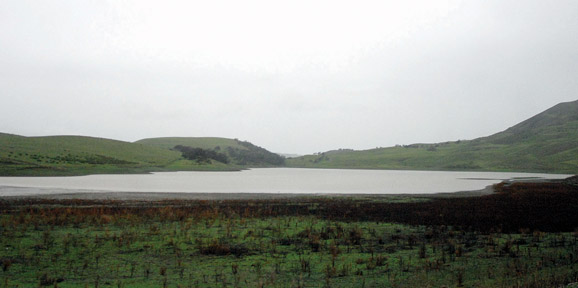
Recent storms put county ahead of yearly pace for rainfall
A week’s worth of wet weather is gradually refilling reservoirs
and ranch ponds in San Benito County, pushing the year-to-date
rainfall well ahead of the average.
”
It has helped,
”
said San Benito County Water District Manager Jeff Cattaneo.
”
We’re putting water into the Paicines and Hernandez reservoirs,
which were effectively empty
”
prior to the recent spate of storms.
Recent storms put county ahead of yearly pace for rainfall
A week’s worth of wet weather is gradually refilling reservoirs and ranch ponds in San Benito County, pushing the year-to-date rainfall well ahead of the average.
“It has helped,” said San Benito County Water District Manager Jeff Cattaneo. “We’re putting water into the Paicines and Hernandez reservoirs, which were effectively empty” prior to the recent spate of storms.
“We’re actually significantly ahead of where we’d be in an average year,” Cattaneo said on Monday, as another storm doused the area throughout the day. “It’s trending fairly close to what 1998 was,” when San Benito County experienced one of its wettest winters on record.
The rain gauge at the water district was close to 11 inches at the start of the week, just two inches below the yearly average.
“As long as it keeps up, we’ll be able to fill both of our local storage reservoirs,” Cattaneo said, noting that the intense rainfall over the past week or so provided the runoff required to raise the water level at the Paicines and Hernandez facilities in the southern part of the county.
Both reservoirs are used to capture and store water which will be released into creeks and the San Benito River later in the year to recharge underground aquifers. The water district cleaned out sediment from the Paicines Reservoir, just south of Bolado Park, before the rainy season to increase storage capacity.
“Rather than let that water run out to the Pajaro River, we capture and release it to streams later in the season to increase recharge” of the groundwater supply, Cattaneo said.
Paicines holds 3,000 acre feet of water and Hernandez holds 17,500 acre feet. An acre foot of water is equal to 325,851 gallons.
“Paicines is rather small, so we’d typically release its water in the summer and refill it in the winter when the San Benito River is running,” Cattaneo said. “At Hernandez, we’d normally have carry-over storage, but because of three years of drought there wasn’t enough water so we had to deplete all of the reservoirs.”
The recent wet weather helps, though doesn’t solve, the water deficit.
“The storms haven’t had any negative impact; there has been no damage from flooding at the district’s facilities,” Cattaneo said, noting that despite significant rainy periods, the San Benito River isn’t running like it was during the El Nino storms of 1998. “The actual run-off that we’re seeing right now is significantly less that you would have seen in February of ’98. We’ve had one or two fairly good storms, but it takes quite a bit of rain to get the river running full.”
County Agriculture Commissioner Ron Ross said that “so far, the impacts have been positive” from the rainy weather.
“I spoke to a couple of cattle ranchers in South County, and their reservoirs are filling up quickly,” he said. “It’s critical that these stock ponds be filled for when the rains stop.”
Ross said he has only heard positive news about the January rain.
“I haven’t gotten any reports of any fields being flooded because they weren’t draining properly,” he said. “As long as the rains come when they’re supposed to and not when crops are being harvested, it’s welcome.”
Despite the positive news associated with the rain, the county water district this week voted to raise its water delivery rates in one of its delivery zones as it moves to a three-year rate structure.
“Because of the restrictions in the Delta and the lowered allocation from the Bureau of Reclamation, we have less water to sell,” Cattaneo said. “Our costs are fixed at the district, so with fewer acre feet of water it causes the price of water to go up. We’re doing everything we can to hold that cost down. The big thing is to restore the pumping we’ve lost in the Delta so we can increase our water supply.”
The water district’s board of directors voted after a public hearing Monday to raise the per-acre-foot cost of agricultural water in Zone 6 to $135 from $115 and the cost of municipal and industrial water to $200-per-acre-foot from $180. Zone 6 runs from Tres Pinos through Hollister and west to Highway 101 through the San Juan Valley, Cattaneo said. It also runs north from Hollister up San Felipe to Shore Road and encompasses everything east of that.









